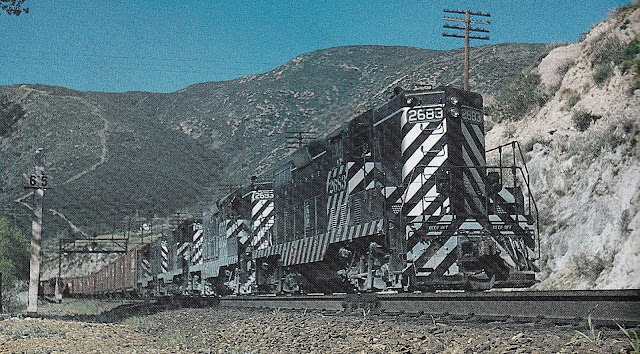Our locomotives this time are the EMD GP7 diesels of the Santa Fe, which were all in the Zebra Stripe paint scheme during my postwar time period. I don't have much layout progress to report this time, due to all the holiday preparations and activities, but I'll mention a few things at the end of this post.
From Sep. 1950 through Dec. 1953 the Santa Fe bought 249 GP7 road switchers, numbered 2650-2893 (including five GP7B units). It appears from photos that those running on Cajon Pass were almost all numbered lower than 2700, which makes them "Phase 1 Late." But the most visible differences among these were that some had dynamic brakes and some did not. Also, #2650-2654 had steam generators and air tanks on the roof.
Here we see #2883 and #2693 leading two other units as the four road engines on an eastbound freight at Keenbrook in May, 1955, thanks to C.H. Kerrigan:
Here's another set of four GP7s serving as road engines on a westbound freight at Frost, after leaving Victorville, in an undated Santa Fe photo. The locos are #2677, 2673, 2665, and 2676, none of which have the dynamic brake bulge along the top of the hood:
But we usually see the GP7s being used as helpers on Cajon Pass. Here is #2696 with #2740 pushing behind the caboose of an eastbound freight at the Pine Lodge grade crossing In Jan. 1955, thanks to Stan Kistler:
Here is #2685 helping the eastbound Grand Canyon at Pine Lodge in the early 1950s, as shot by Don Richardson:
Stan Kistler shot #2691 helping 2-10-2 #3889 with an eastbound freight in Cajon Pass in June of 1952:
I was pleased to see this Stan Kistler photo of #2683 and #2651 helping on the rear of an eastbound freight at Cajon in April of 1954, because it shows one of the units (#2651) with the air tanks on the roof in action on Cajon Pass and not limited to service on the San Bernardino Local:
Here we see three helpers (#2695, #2820, and a UP diesel) leaving Summit westbound to return to San Bernardino. John Shaw shot this photo in Jan. 1955:
Finally, here are #2696 and #2691 as road engines on a westbound freight at Summit, after climbing up from Victorville in the fall of 1951, thanks to Don Sims:
By the way, a GP7 alternated with an H16-44 as the Victorville local switcher after 1951, but I haven't found any photos of a GP7 in this role, nor while pulling the local Oro Grande Turn, which they also did.
There have been many HO models of Santa Fe GP7s, but I'll only cover the most popular and most recent models. I have some of the Proto 2000 models, as seen here with a dynamic brake:
Atlas also made a model, as seen here:
The Athearn Genesis models included those with no dynamic brake:
Walthers Proto made a model with a steam generator and the air tanks on the roof (#2650-2654):
Athearn Genesis even made a model of a GP7 with a GP7B (#2788-2792), which were not seen on Cajon Pass, but I had to have a set anyway:
As I said, I don't have much layout progress to report, due to the busy holiday season. But one morning Bill Messecar visited me again and soldered more feeder wires to the rails of the outer mainline, as seen here:
I had used some 18 gauge wires for the longer feeders, but Bill said those were not needed and were harder to solder, so I replaced those with 22 gauge solid wires while he was doing the soldering work.
I had a major setback when Richard Mukai, who was planning to build my control panels, decided to drop out of the project. So now I'm reading and watching videos (using links sent to me by Don Hubbard) about how to build them myself, with advice from Tim Repp, Tim Fisher, and Bill Messecar.
I'm in the process of redrawing the designs for the three mainline panels, and I will be shopping online for all the swtiches and toggles and rotaries to use on the panels, thanks again to Tim Fisher's advice.
And there is always more to be done with adding more Velcro straps for the bus wires, connecting more feeders to the bus wires, adding labels to all the wires, and laying more cork sheets to support the staging yard tracks.
The dream is to get the entire lower deck and all of its tracks and wires finished by the end of 2023, but we shall see how it goes. I'll be contacting my group of volunteers to see who can help in the coming weeks.














No comments:
Post a Comment